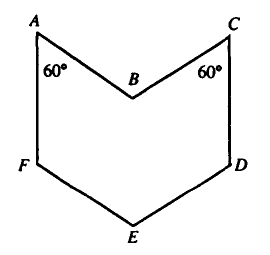1983 AHSME Problems/Problem 4
Problem 4
In the adjoining plane figure, sides ![]() and
and ![]() are parallel, as are sides
are parallel, as are sides ![]() and
and ![]() ,
and sides
,
and sides ![]() and
and ![]() . Each side has length
. Each side has length ![]() . Also,
. Also, ![]() .
The area of the figure is
.
The area of the figure is
![]()
Solution
![[asy] pair A, B, C, D, E, F; A = (0, 1.732); B = (0.5, 0.866); C = (0,0); D = (1, 0); E = (1.5, 0.866); F = (1, 1.732); draw(A--B--C--D--E--F--A); label("$A$", A, NW); label("$B$", B, 3W); label("$C$", C, SW); label("$D$", D, SE); label("$E$", E, E); label("$F$", F, NE); draw(B--D, dashed+linewidth(0.5)); draw(B--E, dashed+linewidth(0.5)); draw(B--F, dashed+linewidth(0.5)); [/asy]](http://latex.artofproblemsolving.com/b/d/d/bddb9e658c2a3f38841b9348a1aa73ffaeadbc5e.png)
By rotating the diagram and drawing the dotted lines, we see that the figure can be divided into four equilateral triangles, each of side length ![]() . The area of one such equilateral triangle is
. The area of one such equilateral triangle is ![]() , which gives a total of
, which gives a total of  , or
, or ![]() .
.
See Also
| 1983 AHSME (Problems • Answer Key • Resources) | ||
| Preceded by Problem 3 |
Followed by Problem 5 | |
| 1 • 2 • 3 • 4 • 5 • 6 • 7 • 8 • 9 • 10 • 11 • 12 • 13 • 14 • 15 • 16 • 17 • 18 • 19 • 20 • 21 • 22 • 23 • 24 • 25 • 26 • 27 • 28 • 29 • 30 | ||
| All AHSME Problems and Solutions | ||
These problems are copyrighted © by the Mathematical Association of America, as part of the American Mathematics Competitions. ![]()










